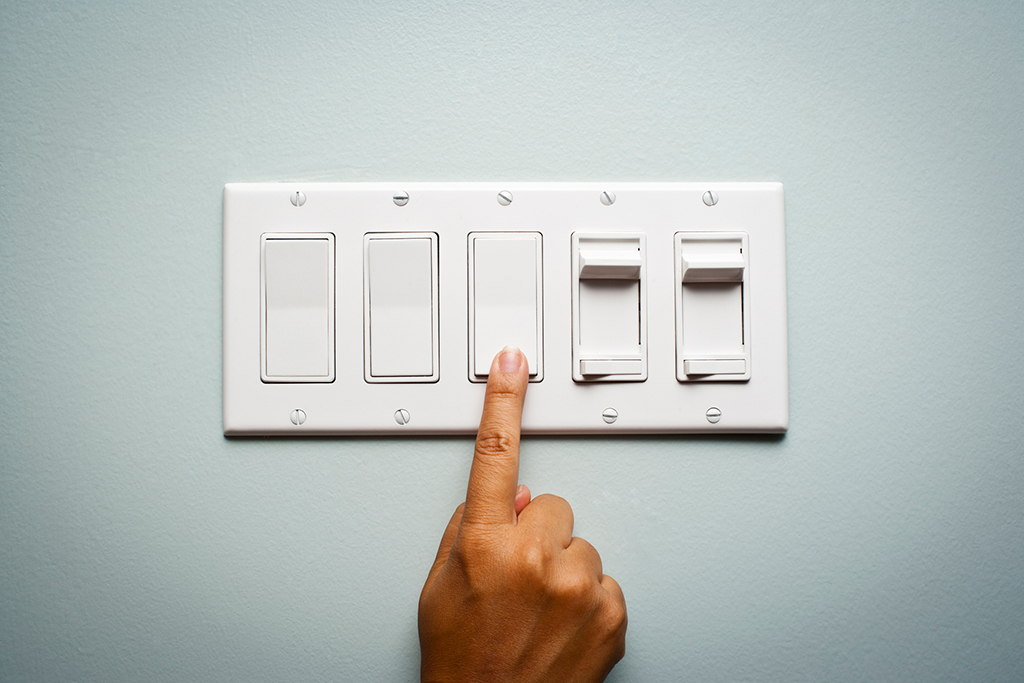An Electrician Explains Different Types Of Switches In Your Home And How They Work | Florence, SC

The switches in your home are a critical component of your electrical system. They are the main control point for controlling and regulating the flow of electricity to various devices, lights, and appliances. Despite their importance in the home, many people don’t know much about them. An electrician has provided this quick overview to help you understand the different types of switches and how they work.
Toggle Switches
Probably the most common type of switch you’ll find in the home is a toggle switch. This type of switch has two positions, usually an “on” and an “off” setting. It is usually used for lighting and frequently turned on and off devices. Unlike other light switches, toggle switches do not indicate whether the light is on or off until you physically push or pull the lever.
Toggle switches work by using two metal contact points inside the switch body. When the handle is pushed down, one contact point will make contact with another contact point completing a circuit and turning on whatever device it controls. Flipping the handle back up breaks contact with both points and turns off the device. The benefit of this type of switch is that it is simple to use and very reliable in operation. However, the handle can wear over time, rendering the switch useless. When the handle on a toggle switch becomes loose, it is best to call an electrician to replace it rather than repair it.
Rotary Switches
Another common type of switch found in the home is a rotary switch. This switch type is often used to control ceiling fans and larger appliances. It consists of a circular dial with several settings, usually corresponding to different speeds and/or positions. Rotary switches cycle through various positions, unlike toggle switches, which provide an instant “on” or “off” result.
Rotary switches use an internal contact system containing many small contacts arranged in an arc around the central shaft. When you rotate the knob or dial, these contacts open and close as they interact inside the switch housing. Different power flows can be created by connecting certain combinations of contacts depending on where the knob is pointing. These connections create a circuit, so when you turn the knob, electricity flows through it for a device to activate or deactivate, depending on its position. Faulty rotary switches are best replaced by an electrician rather than repaired due to their complexity.
Push-Button Switches
The push-button switch is popular in modern homes as it provides more convenience and flexibility than traditional toggle switches. Push-button switches come in two varieties: momentary (single push) and maintained (hold until released). Electricians mostly install these switches to control doorbells, timers, and other simple electrical devices.
Momentary switches only activate when the button is pressed and released instantly, whereas maintained switches stay active until you press the button again to release it. Momentary switches are usually used for single-action items like doorbells and maintained switches for something that needs to stay active, like a timer. Push-button switches operate similarly to toggle switches but with the addition of an internal spring mechanism that keeps the contacts in their default position. Pressing the button pushes against the spring to open or close the contacts and complete the circuit. Call an electrician for repair or replacement if you notice any issues with a push-button switch.
Rocker Switches
A rocker switch is an on/off switch that rocks when pressed. It has two terminals connected by a spring-loaded metal strip. The metal strip is meant to be pushed down with your finger to activate the switch. Pressing the switch one way completes the circuit; it breaks the circuit when pressed the other way. This type of switch is usually rectangular shaped with rounded corners and comes in either single pole (SPST) or double pole (DPST) varieties. Single-pole switches control only one electrical circuit, while double-pole switches can control two circuits at once. Electricians recommend these switches for controlling large appliances like air conditioners or washing machines that require two circuits for operation.
Rocker switches are often confused with toggle switches because they look similar but function differently. A toggle switch has a lever instead of a rocker, which needs to be flipped up or down to activate the switch, whereas a rocker switch needs to be pressed down to activate it.
Timer Switch
Timer switches use a digital or analog clock to control when an electrical device is powered on or off. When the clock is set to turn on, the switch will provide power to the connected device, while when it is set to turn off, the switch will cut off the power supply. This allows you to control any electrical device with just one switch and have it operate according to your desired schedule.
If you hire an electrician to install a timer switch on your lights or other electronic devices, you can ensure that they are only turned on when necessary, saving you money on electricity bills. Additionally, you can get an electrician to install a timer switch on your thermostat, allowing you to keep the temperature in your home at comfortable levels without manually adjusting it throughout the day. Finally, timer switches can also provide peace of mind as they can keep doors locked during certain times of the day or even activate an alarm system automatically. Therefore, electricians recommend timer switches for increased safety and convenience.
Having Issues with Any of the Switches in Your Home? Call Us for Assistance!
At Mister Sparky of Florence, our technicians are experienced in all types of switches, from push-buttons to timers. If you need help troubleshooting or replacing any switch, we’re here to help. We can also provide installation services for new switches if needed. Give us a call today and let us know how we can be of assistance!
See our previous blog on this topic here.
Photo By michellegibson at istock
















